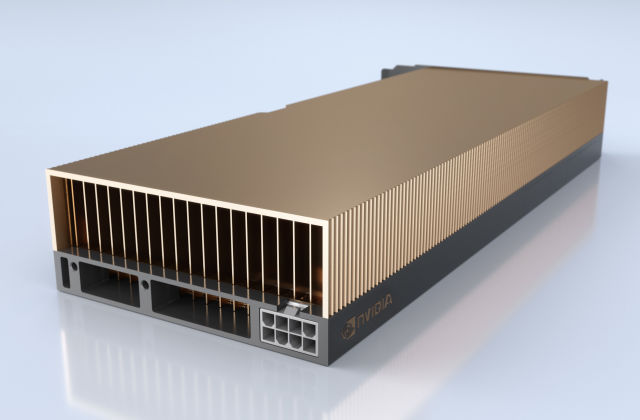Nvidia Replaces Quadro Line with RTX A6000 and RTX A40
Like the Tesla and Titan lines, Nvidia is seemingly dropping the Quadro name.
Nvidia Quadro is dead, long live Nvidia Quadro. Following in the footsteps of the Nvidia A100 that replaces the previous generation Tesla V100, and the Nvidia RTX 3090, which we called the "heir to the Titan throne" in our review, Nvidia today announced two new graphics cards that have the power of the workstation-focused Quadro line, but not the branding. These are the Nvidia RTX A6000 and Nvidia RTX A40, and they each pack Ampere architecture with 10,572 CUDA cores and 48GB of VRAM.
We're not sure why Nvidia's dropping the Quadro branding, but much like the A100 and RTX 3090, it might be that the company's trying to centralize all of its new cards under a simpler "RTX + number" format. We don't know too much about these cards yet, from release date to specs to price. What we do know is that the cards will use 48GB GDDR6 VRAM, which is twice as much as the RTX 3090 but without the 'X' factor.
It appears these cards will basically be RTX 3090s with 16Gb memory modules and Quadro features enabled. That means improved performance in many professional applications, which is an area the Titan line used to straddle and an area where the RTX 3090 falls short.
It appears the choice of memory comes down to ECC (error correcting code) support, which is available on GDDR6 modules but perhaps not GDDR6X. Or it could be that GDDR6X 16Gb modules aren't yet ready for deployment, or that for stability purposes Nvidia prefers the slower speeds of GDDR6. Whatever the case, the A40 specs show 696 GBps of bandwidth (the A6000 doesn't explicitly state bandwidth but does say GDDR6); the RTX 3090 by comparison uses GDDR6X to deliver 936 GBps.
The two cards will also have roughly the same specs, with the key difference being that the A6000 is intended for personal use while the A40 will have connectivity features that make it perfect for data centers. Nvidia also revealed that these cards will only use DisplayPort for video output and will connect to your computer through PCIe Gen 4. And just in case you were worrying about cards that are more powerful than the 3090 not being able to support VR, yes, they will.
These specs are probably going to be overkill for most gamers, so like the previous-gen Quadro line, these cards will instead be positioned toward professional design, research and business markets. To this end, they'll also have features like easy virtualization, which will let you split a single workstation into several virtual instances that can be accessed remotely. They'll also be compatible with NVLink, allowing you to connect multiple copies of each card to take on memory-intensive workloads.
The Quadro RTX 8000, which was the last high-end workstation GPU that Nvidia released, cost $5,800 at launch (and will still run you about $5300 to buy now), so don't expect either the A6000 or the A40 to come cheap. You can sign up to be notified of availability for both of these cards on Nvidia's website. Nvidia says the cards should begin shipping in December.
Get Tom's Hardware's best news and in-depth reviews, straight to your inbox.
Michelle Ehrhardt is an editor at Tom's Hardware. She's been following tech since her family got a Gateway running Windows 95, and is now on her third custom-built system. Her work has been published in publications like Paste, The Atlantic, and Kill Screen, just to name a few. She also holds a master's degree in game design from NYU.
-
nofanneeded Yea , so at the end that power plug is placed in the right place here !!! instead of the ugly RTX gaming line .Reply
Why Nvidia ? for real ? -
Shadowclash10 I don't see the point of this? For the 3090, there were pros and cons to dropping the Titan branding. Reviewers are more likely to include it on all their testing. You could argue that the fact that it isn't under Titan branding means it is less likely to appeal to those who just buy it to show off. On the other hand, you could argue that the fact that it uses a new (alright, the GTX 590 doesn't count :P) xx90 naming scheme makes it stand out more. TLDR there were benefits. What's the benefit of this??Reply -
Darkbreeze ReplyNvidia Quadro is dead, long live Nvidia Quadro
This doesn't make ANY sense, at all. LOL. -
Shadowclash10 Reply
Yep lol. Correct format would be, "Quadro is dead, long live RTX!" I guess? Or that was just a jokeDarkbreeze said:This doesn't make ANY sense, at all. LOL. -
PapaCrazy Ironically, the "quadro" marketing theme would have suited the tensor cores' matrix design fairly well.Reply

